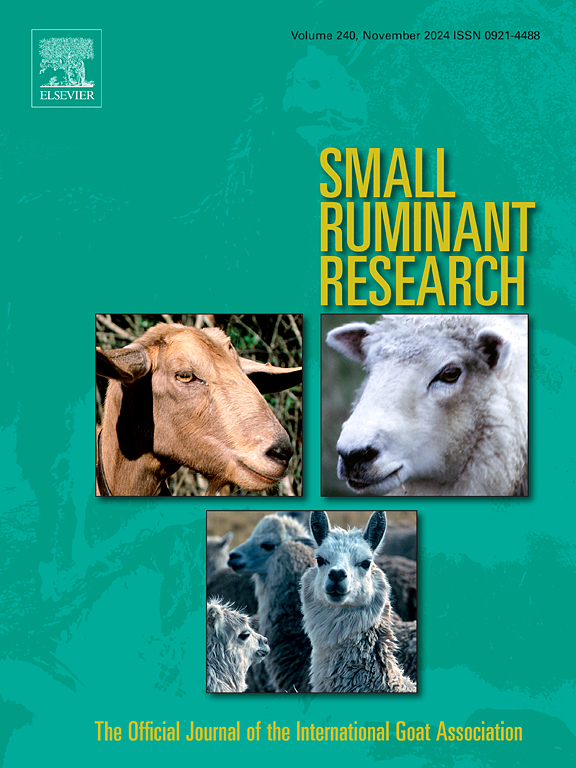用含含水草(野生)干草替代白水草干草饲喂羔羊的瘤胃和肠道形态计量参数
IF 1.6
3区 农林科学
Q2 AGRICULTURE, DAIRY & ANIMAL SCIENCE
引用次数: 0
摘要
本研究旨在评价用含含水草(野生)干草替代牛毛草(Cenchrus ciliaris L.)干草饲喂羔羊的瘤胃乳头和肠绒毛的形态计量学参数。选用初始体重为20.3 ± 1.49 kg的Santa Inês公羊羔28只,采用完全随机设计,分别饲喂0、333、670和1000 g/kg含羞草干草4种处理。瘤胃乳突的宽度不受影响(P >; 0.05),乳突的面积随草干草添加量的增加呈线性减少(P = 0.01)。十二指肠的高度(P & lt; 0.0001)和表面面积(P = 0.01)绒毛的线性增加m . tenuiflora水平下降,而宽度(P = 0.0001)和地区(P = 0.03)下降,达到最小值估计为132.95和50625 .53点 µm在436年和575年 克/公斤的m . tenuiflora干草,分别使用时代替Buffel草干草。在333 g/kg水平下,空肠绒毛高度呈二次增长(P <; 0.0001),最大值为623.22 µm;在526 g/kg水平下,宽度呈二次递减(P = 0.02),最小值为143.33 µm。回肠绒毛高度(P = 0.0003)和各节段隐窝深度(P <; 0.001)呈线性下降。因此,建议在不影响瘤胃和肠道形态参数的情况下,以饲粮中333 g/kg DM的tenuflora干草替代纤毛草干草。本文章由计算机程序翻译,如有差异,请以英文原文为准。
Ruminal and intestinal morphometric parameters of lambs fed diets containing Mimosa tenuiflora (Willd.) hay replacing Buffel grass hay
This study aimed to evaluate the morphometric parameters of the ruminal papillae, and intestinal villi of lambs fed diets containing Mimosa tenuiflora (Willd.) hay replacing Buffel grass (Cenchrus ciliaris L.) hay. Twenty-eight Santa Inês male lambs with initial body weight of 20.3 ± 1.49 kg were used, being distributed in a completely randomized design with four experimental treatments (0, 333, 670, and 1000 g/kg of Mimosa tenuiflora hay). The width of the ruminal papillae was not affected (P > 0.05), while their area decreased linearly (P = 0.01) as the level of M. tenuiflora hay increased. In the duodenum, the height (P < 0.0001) and surface area (P = 0.01) of the villi decreased linearly with increasing M. tenuiflora level, while the width (P = 0.0001) and area (P = 0.03) decreased quadratically, reaching minimum estimated values of 132.95 and 50,625.53 µm at 436 and 575 g/kg of M. tenuiflora hay, respectively, when used as a replacement for Buffel grass hay. There was a quadratic increase in the height of the jejunum villi (P < 0.0001) with a maximum value of 623.22 µm at the level of 333 g/kg, while the width quadratically decreased with a minimum value of 143.33 µm at the level of 526 g/kg and the area linearly decreased (P = 0.02). The height of the ileum villi (P = 0.0003) as well as the depth of the crypts in all segments (P < 0.001) linearly decreased. Therefore, it is suggested the substitution of C. ciliaris hay by M. tenuiflora hay up to 333 g/kg DM of the diet not affecting ruminal and intestinal morphometric parameters.
求助全文
通过发布文献求助,成功后即可免费获取论文全文。
去求助
来源期刊

Small Ruminant Research
农林科学-奶制品与动物科学
CiteScore
3.10
自引率
11.10%
发文量
210
审稿时长
12.5 weeks
期刊介绍:
Small Ruminant Research publishes original, basic and applied research articles, technical notes, and review articles on research relating to goats, sheep, deer, the New World camelids llama, alpaca, vicuna and guanaco, and the Old World camels.
Topics covered include nutrition, physiology, anatomy, genetics, microbiology, ethology, product technology, socio-economics, management, sustainability and environment, veterinary medicine and husbandry engineering.
 求助内容:
求助内容: 应助结果提醒方式:
应助结果提醒方式:


